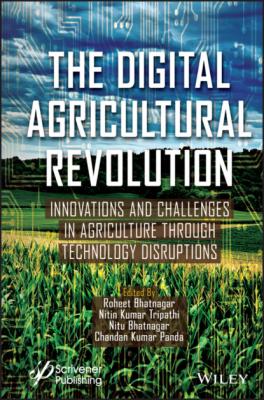The Digital Agricultural Revolution. Группа авторов
Чтение книги онлайн.
Читать онлайн книгу The Digital Agricultural Revolution - Группа авторов страница 19

23. Timesnow, Global water crisis: Groundwater is being pumped 70% faster than expected in North India, research claims, New Delhi, 24 February 2019, https://www.timesnownews.com/mirror-now/in-focus/article/global-water-crisis-groundwater-is-being-pumped-70-faster-than-expected-in-north-india-research-claims/371528#:~:text=Scientists%20mentioned%20that%20the%20groundwater,than%20what%20was%20estimated%20earlier.&-text=Drying%20up%20of%20groundwater%20by,underground%20 water%20is%20much%20higher.
24. Baruah, A., Artificial Intelligence in Indian Agriculture – An Industry and Startup Overview, Emerald, The AI Research and Advisory Company, 2019.
25. Mary, A., Evangeline, S., Minnang, M.R., A beginners guide for machine learning models with python environment, lambert publication, Republic of Moldova, Chisinau-2068, 2019.
26. Digital Agriculture: Farmers in India are using AI to increase crop yields, Microsoft News Center India, 7 November, 2017, https://news.microsoft.com/en-in/features/ai-agriculture-icrisat-upl-india/.
27. Anonyms, Machine Learning, IBM Cloud Education, updated 15 July 2020.
28. Adisa, O., Botai, J., Adeola, A. et al., Application of artificial neural network for predicting maize production in South Africa. Sustainability, 11, 4, 1145–1227, 2019.
29. Chary, S., Mustaffha, S., Ismail, W.I.W., Determining the yield of the crop using artificial neural network method. Int. J. Eng. Adv. Technol., 9, 1, 2959–2965, 2019.
30. Gliever, C. and Slaughter, D.C., Crop verses weed recognition with artificial neural networks, ASAE paper., 01-3104, 2001, 1–12, 2001.
31. Maier, H.R., Dandy, G.C., Neural networks for the prediction and forecasting of water resources variables: a review of modelling issues and applications, Environmental Modelling & Software, 15, 1, 101–124, 2000.
32. Song, H. and He, Y., Crop nutrition diagnosis expert system based on artificial neural networks. third International Conference on Information Technology and Applications (ICITA’05), Sydney, NSW, 1 (2005), pp. 357–362, 2005.
33. Singh, A., Ganapathysubramanian, B., Singh, A.K., Sarkar, S., Machine learning for high-throughput stress phenotyping in plants. Trends Plant Sci., 21, 2, 110–124, 2016.
34. Pan, S.J. and Yang, Q., A survey on transfer learning. IEEE Trans. Knowl. Data Eng., 22, 10, 1345–1359, 2010.
35. Danziger, C., The Environmental Impacts of AI and IoT In Agriculture, aitrends, January 9, 2020, https://www.aitrends.com/ai-in-agriculture/the-environmental-impacts-of-ai-and-iot-in-agriculture/.
36. Abhishek, S., AI for farmers, Indian Express, Updated: November 26, 2020.
37. Jain, P., Artificial Intelligence in Agriculture: Using Modern Day AI to Solve Traditional Farming Problems, aAnalytics Vidhya, November 4, 2020, https://www.analyticsvidhya.com/blog/2020/11/artificial-intelligence-in-agriculture-using-modern-day-ai-to-solve-traditional-farming-problems/.
38. Big data and Agriculture: A Complete Guide, talend, 2020, https://www.talend.com/resources/big-data-agriculture/.
39. Dua, A.M., Artificial Intelligence in Indian Agriculture, Bhajan Global Impact Foundation, updated Feb 2020, http://bhajanfoundation.org/knowledge/artificial-intelligence-in-indian-agriculture/.
1 * Corresponding author: [email protected]
2
Comparative Evaluation of Neural Networks in Crop Yield Prediction of Paddy and Sugarcane Crop
K. Krupavathi1*, M. Raghu Babu2 and A. Mani3
1Department of Irrigation and Drainage Engineering, Dr. NTR College of Agricultural Engineering, Bapatla, ANGRAU, India
2Department of Irrigation and Drainage Engineering, College of Agricultural Engineering, Madakasira, ANGRAU, India
3Department of Soil and Water Engineering, Dr. NTR College of Agricultural Engineering, Bapatla, ANGRAU, India
Abstract
Climate change causing extreme temperature events, erratic pattern of rainfall, droughts and floods poses serious limitations on agriculture, in turn requires regular crop monitoring and management of resources to get maximum yields. Food chain of the crops can be transformed by technological innovations, like mechanization, artificial intelligence and robotics, UAVs, sensors, Internet of Things (IoT), remote sensing, machine learning and deep learning in agriculture. The present study focused on ability of machine learning algorithm in integration with remote sensing in crop yield prediction of paddy and sugarcane crops at regional level. Crop-sensitive parameters extracted from high resolution LANDSAT 8 OLI imageries are used as neural network model inputs. The Feed Forward Back Propagating Neural Network (FFBPNN) models for crop yield were developed and calibrated in MATLAB environment. During training, the model perceptron’s were trained with 75 of the 100 inputs upto10,000 epochs with 1 to 10 hidden neurons. Four performance indices (coefficient of multiple determination, R2; MAE; RMSE and the average ratio between estimated yield to target crop yield [Rratio]) were calculated to achieve optimum neural network. Accurate and stable results observed from the model for paddy with highest mean relative error as 6.166% and the lowest relative error as −0.133%. The range of R2 values were 0.946 and 0.967 for training and same for testing was 0.936 and 0.950 for paddy in Kharif and Rabi seasons, whereas for sugarcane the values are 0.916 and 0.924 during testing and training, respectively. The highest MAE was 0.178 for Paddy (Rabi). The Rratio values showed the under crop yield estimation of sugarcane crop. The model’s best performance was observed at [i+1] and [i+2] hidden nodes. The statistical analysis revealed that the reliability of the model in paddy yield estimation. However, slight under estimation of yield of the sugarcane crop indicates sensitivity of yield algorithms to crop input parameters. The results demonstrated the high efficacy of using remote sensing images and NN models to generate accurate crop yield maps and also revealed significant superiority of neural network models over conventional methods.
Keywords: Crop yield, remote sensing, neural networks, feed forward and back propagation, NDVI, APAR, crop water stress
2.1 Introduction
Climate change posing serious challenges on fresh water and good soil and are becoming serious limitations for agriculture around the world. Average raise in temperatures was causing more extreme heat throughout the year. Rainfall patterns are also shifted more intense